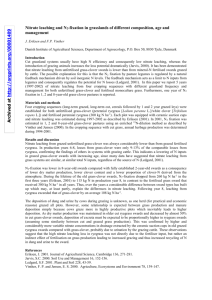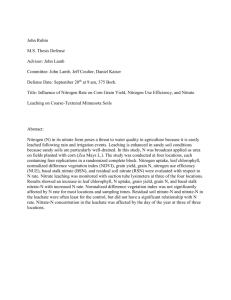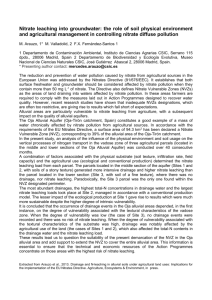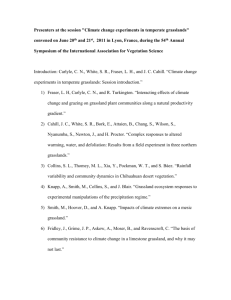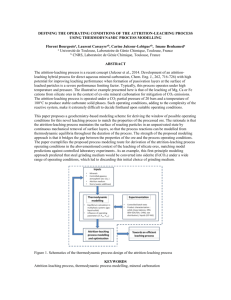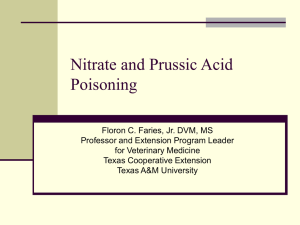Utilization of grassland nitrogen
advertisement
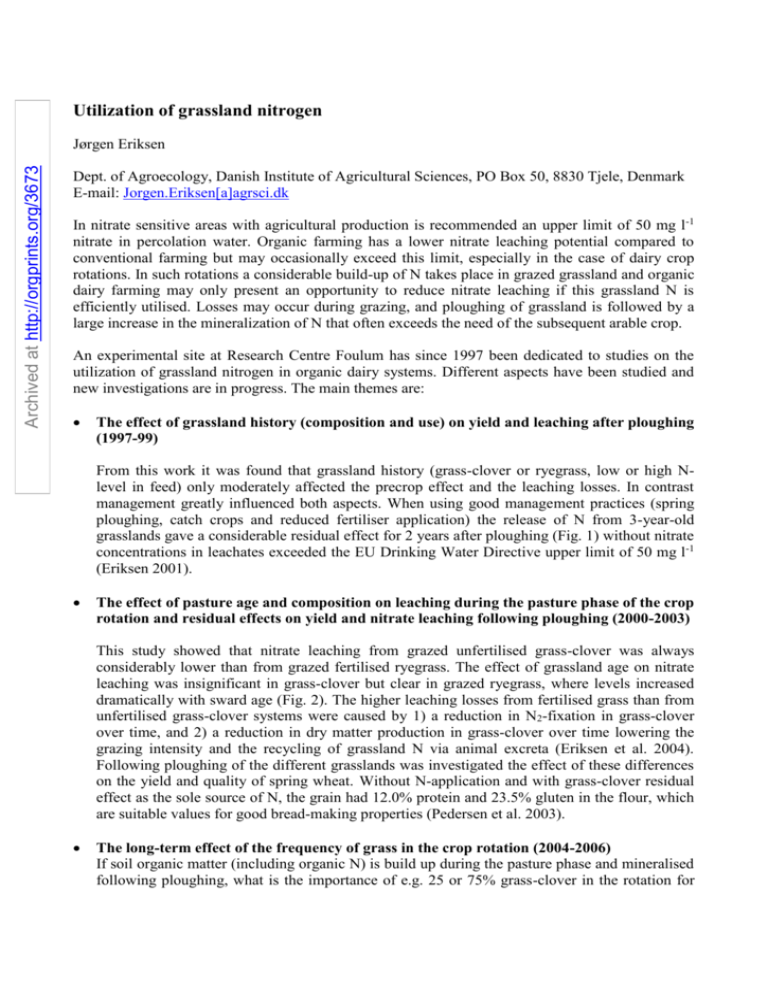
Utilization of grassland nitrogen Archived at http://orgprints.org/3673 Jørgen Eriksen Dept. of Agroecology, Danish Institute of Agricultural Sciences, PO Box 50, 8830 Tjele, Denmark E-mail: Jorgen.Eriksen[a]agrsci.dk In nitrate sensitive areas with agricultural production is recommended an upper limit of 50 mg l-1 nitrate in percolation water. Organic farming has a lower nitrate leaching potential compared to conventional farming but may occasionally exceed this limit, especially in the case of dairy crop rotations. In such rotations a considerable build-up of N takes place in grazed grassland and organic dairy farming may only present an opportunity to reduce nitrate leaching if this grassland N is efficiently utilised. Losses may occur during grazing, and ploughing of grassland is followed by a large increase in the mineralization of N that often exceeds the need of the subsequent arable crop. An experimental site at Research Centre Foulum has since 1997 been dedicated to studies on the utilization of grassland nitrogen in organic dairy systems. Different aspects have been studied and new investigations are in progress. The main themes are: The effect of grassland history (composition and use) on yield and leaching after ploughing (1997-99) From this work it was found that grassland history (grass-clover or ryegrass, low or high Nlevel in feed) only moderately affected the precrop effect and the leaching losses. In contrast management greatly influenced both aspects. When using good management practices (spring ploughing, catch crops and reduced fertiliser application) the release of N from 3-year-old grasslands gave a considerable residual effect for 2 years after ploughing (Fig. 1) without nitrate concentrations in leachates exceeded the EU Drinking Water Directive upper limit of 50 mg l-1 (Eriksen 2001). The effect of pasture age and composition on leaching during the pasture phase of the crop rotation and residual effects on yield and nitrate leaching following ploughing (2000-2003) This study showed that nitrate leaching from grazed unfertilised grass-clover was always considerably lower than from grazed fertilised ryegrass. The effect of grassland age on nitrate leaching was insignificant in grass-clover but clear in grazed ryegrass, where levels increased dramatically with sward age (Fig. 2). The higher leaching losses from fertilised grass than from unfertilised grass-clover systems were caused by 1) a reduction in N2-fixation in grass-clover over time, and 2) a reduction in dry matter production in grass-clover over time lowering the grazing intensity and the recycling of grassland N via animal excreta (Eriksen et al. 2004). Following ploughing of the different grasslands was investigated the effect of these differences on the yield and quality of spring wheat. Without N-application and with grass-clover residual effect as the sole source of N, the grain had 12.0% protein and 23.5% gluten in the flour, which are suitable values for good bread-making properties (Pedersen et al. 2003). The long-term effect of the frequency of grass in the crop rotation (2004-2006) If soil organic matter (including organic N) is build up during the pasture phase and mineralised following ploughing, what is the importance of e.g. 25 or 75% grass-clover in the rotation for soil organic matter mineralization and leaching losses? One hypothesis is that the most grassintensive systems may release unmanageable large amounts of N following ploughing leading to increased nitrate leaching compared to less grass-intensive systems. In this recently started project will be investigated precrop effect and nitrate leaching in crop rotations similar during the last three years, but with widely different grassland frequency in the rotation (25, 38 and 75%). We expect that this provide information on the long-term effect of grass frequency in the crop rotation. These studies at the experimental site in Foulum are currently being supplemented by investigations on a private farm. References Eriksen J. (2001) Nitrate leaching and growth of cereal crops following cultivation of contrasting temporary grasslands. Journal of Agricultural Science 136: 271-281. Eriksen J., Vinther F.P. & Søegaard K. (2004) Nitrate leaching and N2-fixation in grasslands of different composition, age and management. Journal of Agricultural Science. In press. Pedersen L., Eriksen J. & Thomsen I.K. (2003) Baking quality of wheat from different cropping systems. Newsletter from Danish Research Centre for Organic Farming. Dec. 2003 no. 4. (http://www.darcof.dk/enews/dec03/bake.html) Cereals Grass Grass-clover Grain yield (t DM ha-1) spring barley Year 1 5 4 3 2 0 100 0 100 0 100 0 100 0 100 0 100 Grain yield (t DM ha-1) spring wheat Year 2 3.5 3.0 2.5 2.0 DM yield (t ha-1) barley wholecrop Year 3 9 8 7 6 5 4 3 0 100 Mineral fertilizer (kg N ha-1) 0 100 Slurry (kg NH4-N ha-1) 0 100 Slurry (kg NH4-N ha-1) Cut Grazed; low N Grazed; high N Fig. 1. Yields of barley grain, wheat grain and barley wholecrop in three years following ploughing of grasslands and compared to similar yields following a cereal history. Low and high N refers to 140 and 300 g N per cow per day, respectively, in supplements to cows during grazing. Error bars: SE. Grass-clover 150 Ryegrass a kg NO3-N ha -1 125 100 a 75 ab 50 25 a b b ab b 0 8. 8. 2. 1. 8. 8. 2. 1. yr yr yr yr yr yr yr yr t cu az gr az gr az gr t cu az gr az gr az gr ed ed ed ed ed ed Fig. 2. Nitrate leaching from grasslands of different composition, management and age. Bars with the same letter are not significantly different within each grass type (P<0.05). Error bars: SE.
